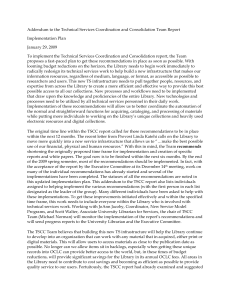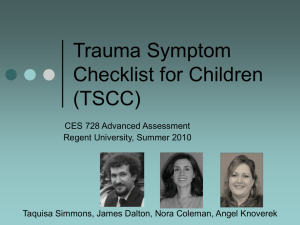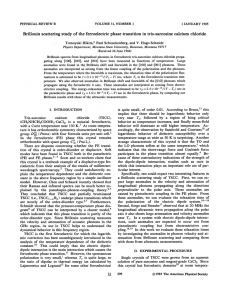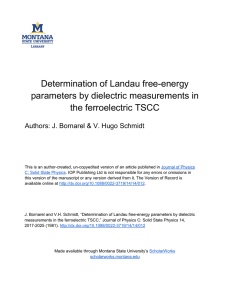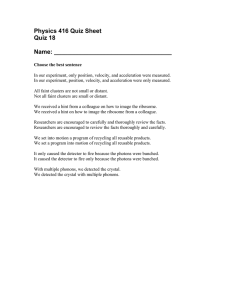Brillouin scattering near the ferroelectric phase transition in TSCC
advertisement
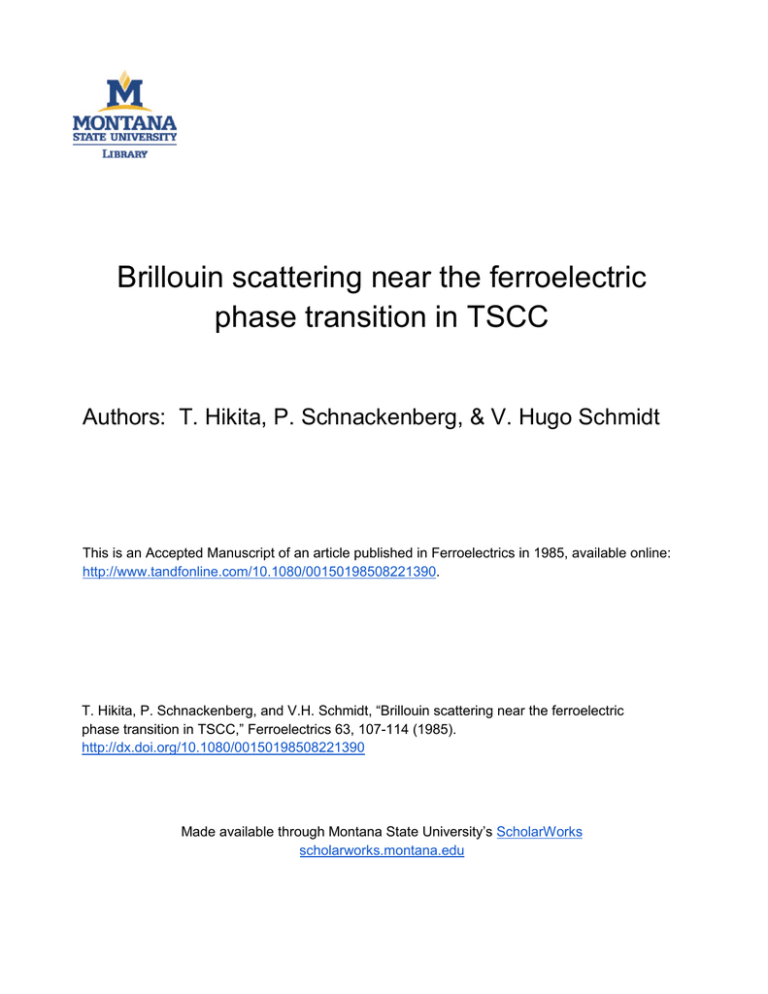
Brillouin scattering near the ferroelectric phase transition in TSCC Authors: T. Hikita, P. Schnackenberg, & V. Hugo Schmidt This is an Accepted Manuscript of an article published in Ferroelectrics in 1985, available online: http://www.tandfonline.com/10.1080/00150198508221390. T. Hikita, P. Schnackenberg, and V.H. Schmidt, “Brillouin scattering near the ferroelectric phase transition in TSCC,” Ferroelectrics 63, 107-114 (1985). http://dx.doi.org/10.1080/00150198508221390 Made available through Montana State University’s ScholarWorks scholarworks.montana.edu 0 1985 Gordon and Breach, Science Publishers, Inc. and OPA Ltd. Printed in the United States of America Ferroehetnes, 1985, Vol. 63, pp. 107-1 14 0015-0193/85/6301 -0107/$15 .OO/O BRILLOUIN SCATTERING NEAR THE FERROELECTRIC PHASE TRANSITION I N TSCC TOMOYUKI HIKITA*, PAUL SCHNACKENBERG AND V. HUGO SCHMIDT Physics Department, Montana S t a t e University, Bozeman, Montana 59717 U.S.A. Abstract B r i l l o u i n s p e c t r a from l o n g i t u d i n a l phonons in f e r r o electric t r i s - s a r c o s i n e calcium c h l o r i d e (TSCC) propagating along IlOOJ, lOl0’) and [OOll have been measured as f u n c t i o n s of temperature. Large anomalies were found i n t h e B r i l l o u i n s h i f t and l i n e w i d t h in t h e I 100) and [ 001) phonons. These anomalies are i n t e r p r e t e d as a r i s i n g from t h e l i n e a r coupling of t h e p o l a r i z a t i o n and phonons. From t h e t h e temperature where t h e l i n e w i d t h is maximum, t h e r e l a x a t i o n time f t h e p o l a r i z a t i o n sec, where f l u c t u a t i o n s is estimated t o be 7=3.lxl0-lq/(Tc-T) T, is t h e f e r r o e l e c t r i c t r a n s i t i o n temperature. W e a l s o observed anomalies i n B r i l l o u i n s h i f t and l i n e w i d t h of t h e [ O l O ] phonons which propagate along t h e f e r r o e l e c t r i c a x i s . These anomalies are i n t e r p r e t e d as roming from e l e c t r o s t r i c t i v e couThe energy r e l a x a t i o r time m s estimated t o be rE’2.5 xl0plinfb/(T-Tc) sec in t h e pardelectr2-c (PE) phase and .O x10- 9 /(T-Tc) sec i n t h e f e r r o e l e c t r i c (FE) phase, by comparing our B r i l l o u i n r e s u l t s w i t h t h o s e f t h e u l t r a s o n i c measurements. INTRODUCTION Tris-sarcosine calcium c h l o r i d e (TSCC) i s a u n i a x i a l f e r r o e l e c t r i c , w i t h a Curie temperature near 130 K.l A t room temperature i t has orthorhombic symmetry c h a r a c t e r i z e d by space group D2i6-Pnma with f o u r formula u n i t s per u n i t c e l l . 2 I n t h e FE phase t h i s c r y s t a l 9 remains orthorhombic with spase group C2v-Pna21. There a r e d i s p u t e s concerning whether t h e FE t r a n s i t i o n of t h i s c r y s t a l i s order-disorder o r d i s p l a c i v e . S o f t modes have been found 3-5 S c o t t ’ s group c l a i m s that i n TSCC both i n t h e PE and FE phases. t h i s c r y s t a l is a textbook example of a d i s p l a c i v e t y p e f e r r o e l e c t r i c from t h e i r a n a l y s i s of t h e r e s u l t s 107 of m i l l i m e t e r wavelength spec- T. HIKITA, P. SCHNACKENBERG AND V. H. SCHMIDT 108 t r o ~ c o p y .They ~ could s a t i s f a c t o r i l y e x p l a i n t h e t e m p e r a t u r e dependence of t h e d i e l e c t r i c c o n s t a n t i n t h e above frequency r e g i o n by a simple o s c i l l a t o r model. However, Chen and Schaack r e c e n t l y showed t h a t t h e i r Raman and i n f r a r e d s p e c t r a can b e much b e t t e r e x p l a i n e d by t h e pseudospin-phonon c o u p l i n g t h e o r y . 6 y They concluded t h a t TSCC and p a r t i a l l y brominated TSCC (5.e. TSCC1-xBx) undergo phase t r a n s i t i o n s which are mostly of t h e o r d e r - d i s o r d e r type. 6 9 7 Furthermore, Schmidt showed that t h e pressure-temperature diagram’ phase of TSCC can be i n t e r p r e t e d by a c l u s t e r model,’ which i n d i c a t e s t h a t t h i s phase t r a n s i t i o n i s p a r t l y of t h e o r d e r - d i s o r d e r type. S i n c e B r i l l o u i n s c a t t e r i n g measures t h e v e l o c i t y and attenu a t i o n o f a c o u s t i c phonons i n t h e GHz r e g i o n , i t s u s e i n TSCC h e l p s t o understand t h e dynamical behavior i n t h i s frequency r e g i o n . EXPERIMENTAL S i n g l e c r y s t a l s of TSCC w e r e grown from a n aqueous s o l u t i o n of p u r e sarcsine and r e a g e n t g r a d e CaC12. S i n c e t h i s c r y s t a l has f e r r o e l a s t i c domains a t room temperature, s i n g l e domain p o r t i o n s were c a r e f u l l y examined w i t h a p o l a r i z i n g microscope. E x c e p t i o n a l l y c l e a r p a r t s were chosen from t h e s e c r y s t a l s and two samples which have t h e form 3 of a r e c t a n g u l a r p a r a l l e l e p i p e d 3 x 3 ~ 2mm were prepared. One sample was c u t so t h a t t h e - l o n g i t u d i n a l phonons q I1 [lo01 and q 11 [OlOl could be measured by r i g h t a n g l e s c a t t e r i n g and t h e o t h e r w a s c u t so that l o n g i t u d i n a l phonons q I\ LO011 and q I] [0101could b e measured. The two samples w e r e p o l i s h e d and t h e n masked t o g e t h e r by a blackened coper f o i l w i t h p i n h o l e s f o r t h e i n c i d e n t and t h e s c a t t e r e d l i g h t beams. The masked sample p a i r was p l a c e d i n a h i g h p r e s s u r e o p t i c a l c e l l d e s c r i b e d previously.” The c e l l w a s f i l l e d w i t h i s o p e n t a n e f o r index matching. The o p t i c a l c e l l t e m p e r a t u r e could be c o n t r o l l e d w i t h i n 3 mK during t h e measurement. A L e x e l Model 95-2 argon laser o p e r a t i n g i n a s i n g l e mode a t a wavelength of 514.5 nm and a power level of 200 t o 300 mW was used as a l i g h t source. The s c a t t e r e d l i g h t was c o l l e c t e d i n a c o n e of 109 BRILMUIN SCATTERING OF TSCC 1' and analyzed by a p i e z o e l e c t r i c a l l y scanned Burleigh Model 140 Fabry-Perot i n t e r f e r o m e t e r . F i n e s s e o p t i m i z a t i o n and d r i f t c o n t r o l were achieved by a home-made c o n t r o l system using an AIM-65 microcomputer . RESULTS AND DISCUSSION F i g u r e s 1-3 show t h e temperature dependence of t h e B r l l o u i n s h i f t and l i n e w i d t h f o r l o n g i t u d i n a l phonons propagating along [ 1001 , [ O l O l and [ O O l I . The temperature dependence of t h e B r i l l o u i n s h i f t and t h e decay r a t e of t h e [lo01 phonons i s q u i t e similar t o that of t h e [ O O I ] phonons though t h e anomlies a r e smaller f o r t h e l a t t e r c a s e . I n t h e above t w o cases, t h e p o l a r i z a t i o n and t h e s t r a i n couple For t h e s e two phonon propagations, t h e 12-14 the attenuation i n t h e FE phase a r e given by b i l i n e a r l y i n t h e FE phase." v e l o c i t y v and v 2 2 2 2 9 2 -2 = v,- [(V,-Vo)/(l+W-Tot ..'--. )I, TSCC q // Do01 '.i Figure 1 Temperature dependence of B r i l l o u i n s h i f t linewidth (0) along t h e (0) and (FWHM) of l o n g i t u d i n a l phonons i n TSCC propagating [loo] d i r e c t i o n . The s c a t t e r i n g geometry is xSy(zz)-xSy. T. HIKITA, P. SCHNACKENBERG AND V.H. SCHMIDT 110 c1 = [(v,-vo)/2v,l[ 2 2 3 w2 Tot-l/(l+w 2 Tot 2 -2 11 where t is t h e reduced temperature (Tc-T)/T,, . (3) To is t h e i n d i v i d u a l for t h e r e l a x a i o n d i p o l e r e l a x a t i o n time i n t h e e x p r e s s i o n ==Tot-' t i m e T. From Eq. (2) we n o t i c e that t h e phase t r a n s i t i o n is marked by a q u i c k d r o p i n t h e v e l o c i t y w i t h d e c r e a s i n g temperature. However, e x p e r i m e n t a l l y t h e [lo03 and [ O O l ] phonon v e l o c i t i e s do n o t e x h i b i t . t, 20.6 I .: z W e TSCC q//[OIO] -......*.*.-. ## 20.2 I - 200 5 0 5 . D TEMPERATURE (K) Figure 2 z 100 ; Temperature dependence of B r i l l o u i n s h i f t (0) and l i n e w i d t h (0) (FWHM) of l o n g i t u d i n a l phonons i n TSCC propagating along t h e [ O l O ] d i r e c t i o n . The s c a t t e r i n g geometry i s x+y(zz)x-y. -I" P ... . .. +- &I.* 4 21.6- t 21.48 L - -. - . .. .. . 1 " " I " " I " " ~ J " ' *. *a. * * i TSCC q//[ooll 21.2- - 400 TEMPERATURE (K) F i g u r e 3 Temperature dependence of B r i l l o u i n s h i f t (0) and l i n e w i d t h (0)(FWHM) of l o n g i t u d i n a l phonons i n TSCC propagating a l o n g t h e [OOll d i r e c t i o n . The s c a t t e r i n g geometry i s x+y(xx)y-z. BRILLOUIN SCATTERING OF TSCC 111 such s h a r p d r o p s a t Tc, b u t r a t h e r slow rounding. These anomlies are a t t r i b u t e d t o t h e q u a d r a t i c coupling of t h e p o l a r i z a t i o n and t h e s t r a i n or i n o t h e r words, e l e c t r o s t r i c t i v e coupling. 11y15Such con- t r i b u t i o n s t o t h e anomalies of t h e v e l o c i t y and t h e a t t e n u a t i o n are s c h e m a t i c a l l y i l l u s t r a t e d i n Fig. 4. As we see from Fig.4, t h e tem- p e r a t u r e Tm a t which t h e a t t e n u a t i o n c o e f f i c i e n t is maximum does n o t equal Tc,but occurs somewhat below Tc. From Eqs. (2) and (3) w e obtain the relation (Tc-T,)/Tc=~~o. By t h i s r e l a t i o n w e can calcu- l a t e t h e elementary r e l a x a t i o n time. Though t h e c l e a r i n d i c a t i o n of TC i s b l u r r e d by t h e a d d i t i o n a l small anomaly from t h e e l e c t r o s t r i c t i v e c o n t r i b u t i o n s , w e can u s e t h e s t e e p e s t dropping p o i n t of t h e v e l o c i t y a s Tc. From t h e v e l o c i t y and a t t e n u a t i o n f o r t h e above two cases, we o b t a i n t h e following r e s u l t s : For t h e q11[1001 phonons,-ro= 2.4x10-l~ sec, and f o r t h e 911 -14 [ 0013 phonons ,~ ~ = 2 . 3 x l O sec . These two r e s u l t s a g r e e s w e l l . w e w i l l u s e t h e i r average, ~ , = 2 . 4 x 1 0 - l ~sec. We next consider t h e temp e r a t u r e dependence of t h e B r i l l o u i n s h i f t and t h e phonon decay rate f o r t h e l o n g i t u d i n a l phonons p a r a l l e l t o t h e spontaneous pol a r i z a i o n . I n t h i s case, p o l a r i z a t i o n f l u c t u a t i o n s do n o t c o u p l e b i l i n e a r l y t o t h e s t r a i n , because Figure 4 Anomalies i n t h e of t h e appearance of t h e depolar- v e l o c i t y and t h e a t t e n u a t i o n ization f i e l d i n the longitudinal caused by p i e z o e l e c t r i c cou- p o l a r i z a i o n wave. 15’l6 Therefore, p l i n g and e l e c t r o s t r i c t i v e t h e anomalies i n t h e v e l o c i t y and coupling f o r l o n g i t u d i n a l a t t e n u a t i o n of t h e s e phonons phonons propergating per- should b e expained by q u a d r a t i c pendicular t o t h e p o l a r i z a - coupling of t h e p o l a r i z a t i o n t o tion axis. t h e strain in both PE and FE T. HIKITA, P. SCHNACKENBERGAND V. H. SCHMIDT 112 phases. We now compare t h e v e l o c i t y and a t t e n u a t i o n of t h e a c o u s t i c waves in t h e GHz and MHz regions. Ultrasonic v e l o c i t y and attenuat i o n measurements have been performed on t h i s c r y s t a l by Sorge and Straube.17 Their r e s u l t s are reproduced in Figs. 5 and 6, together with our B r i l l o u i n r e s u l t s which are converted t o t h e v e l o c i t y and a t t e n u a t i o n scale. We u s e t h e v e l o c i t i e s obtained by B r i l l o u i n s c a t t e r i n g and and vo, r e s p e c t i v e l y . W e assume t h e E -1 s i m p l e s t form f o r t h e r e l a x a t i o n time t o be7E=To t , where7: i s u l t r a s o n i c measurements f o r v, t h e elementary r e l a x a t i o n time. The E designates that t h e s e relaxat i o n times a r e r e l a t e d t o energy r a t h e r than p o l a r i z a t i o n f l u c t u p u t t i n g i n t o Eq. (3) t h e values of t h e a t t e n u a t i o n a t i o n s . By c o e f f i c i e n t of t h e u l t r a s o n i c measurements a t , t h e temperature T-Tc= =0.9K and -1.3 K (2.7 db/cm and 11.1 db/cm, r e s p e c t i v e l y ) , we E -12 obtain t h e following values of t h e r e l a x a t i o n time: ~ r ~ = 1 . 9 x l O E -12 sec f o r T)T, andTo=7.7x10 sec for TCT,. Chen and S ~ h a a c k obtaied ~’~ T , = ~ . ~ x I O sec - ~ ~from t h e i r analy- sis of t h e pseudospin-phonon coupling of Raman and i n f r a r e d s p e c t r a . This value i s one order of magnitude l a r g e r than ours. Deguchi e t showed that t h e r e l a x a t i o n time i n TSCC i s expressed byTe3.8 c,) sec from t h e i r d i e l e c t r i c d i s p e r s i o n measurements. I f w e use t h e values + r e l a t i o n C /C-=2, + C =30 t o 50 K f o r t h e Curie constant 19’20 and t h e -14 we obtain t h e valuesT,=4.4 t o 8 . 5 ~ 1 0 sec f o r t h e elementary r e l a x a t i o n time which i s in r e l a t i v e l y good agreement with our values. Though we can obtain an order-parameter r e l a x a t i o n time from t h e B r i l l o u i n s c a t t e r i n g experiment, t h i s does n o t n e c e s s a r i l y mean t h a t TSCC undergoes an order-disorder phase trans i t i o n s . It is a l s o p o s s i b l e t o adopt t h e i n t e r p r e t a t i o n t h a t s o f t mode frequency wedecreases and t h e damping constant Y diverges a s Tc i s approached. I n such an extremely damped case, t h e system has t h e same c o r r e l a t i o n function a s t h a t of t h e r e l a x a t i o n a l mode where 2 t h e e f f e c t i v e r e l a x a t i o n time i s given by Y / w o . Recently, Sugo et a1.21 performed an p r e c i s e Raman measurements i n t h e f e r r o e l e c t r i c BRILLOUIN SCATTERING OF TSCC 113 TEMPERATURE (K) Figure 5 Temperature dependence of sound v e l o c i t y i n TSCC for Brillouin (BS) a t 16 GHz and for ultrasonic (US) measurements a t 20 MHz. The v e l o c i t y s c a l e f o r the Brillouin scattering was adjusted t o that of the ultrasonic measurements. TSCC I .o q//C0103 1 i TEMPERATURE (K) Figure 6 Temperature dependence of the attenuation in TSCC f o r Brillouin scattering (BS) a t 16 GHz and for ultrasonic (US) measurements a t 20 MHz. T. HIKITA, P. SCHNACKENBERG AND V. H.SCHMIDT 114 phase of TSCC up to Tc. They showed that w o 2 / 7 is nearly propor- tional to Tc-T near Tc (within about 10 K) and 7=5.9xlO-" Tc-0.05 K. ture. eec at Our result gives T = 6 . 3 ~ 1 0 - ~sec ~ at the same tempera- REFERENCES 1. 2. Y. Makita, J. Phvs. SOC. JDn., 20, 2073 (1965). Cryst., B 28, T. Ashida, S. Bando and M. Kakudo, 1560 (1972). S. D. Prokhorova, G. A. Smolensky, I. G. S h y , E. G. Kuzminov, V. D. Mikvabia and H. Arndt, Ferroelectrics, 25, 629 (1980). 4. G. E. Feldkamp, J. F. Scott and W. Windsch, Ferroelectrics, 39, 1163 (1981). 5. G. V. Kozlov, A. A. Volkov, J. F. Scott, G. E. Feldkamp and J. Petzelt, Phvs. Rev. B, 28, 255 (1983). 6. T. Chen and G. Schaack, to appear in J. Phvs. C, l7, (1984). 7. T. Chen and G. Schaack, to appear in J. Phys. C, 17, (1984). 8. V. H . Schmidt, Solid State Commun., 35, 649 (1980). 9. V. H. Schmidt, Ferroelectrics, 2,1151 (1981). 10. M. Yamada and V. H. Schmidt, Rev. Sci. Instr., 49, 1226 (1978). 11. W. Rehwald, Adv. Phvs., 22, 721 (1973). 12. R. W. Gammon and H. 2. Cummins, Phvs. Rev. Lett., l7, 3. 13. 193 (1966). T. Yagi, M. Tokunaga and I. Tatsuzaki, J. Phvs. Soc- Jvn., 40, 1659 (1976). 73, 467 (1982). 14. K. F. Herzfeld and T. A. Litovitz, Absorption g& Dispersion of Ultrasonic Waves (Academic Press, New York, 1959). 15. K. A. Minaeva, B. A. Strukov and K. Varnstorff, Sov. Phvs. Sol. State, l0, 1665 (1969). 16. M. A. Krivoglaz, Sov. Phvs. Sol. State, 2, 2526 (1963). 17. G. Sorge and U. Straube, Ferroelectrics, 21, 533 (1978). 18. K. Deguchi, N. Aramaki, E. Nakamura and K. Tanaka, J. Phys. SOC. Jon., 52, 1897 (1983). 19. E. Sandvold and E. Courtens, Phvs. Rev. B, 27, 5660 (1983). 20. U. Straube, G. Sorge and N. R. Ivanov, Phvs. Status S o l . (a), 21. *On M. Sugo, M. Kasahara, M. Tokunaga and I. Tatsuzaki, J. Phvs. SOC. Jon., 53, No. 9 (1984). - leave from Tohoku University, Sendai 980, Japan.
